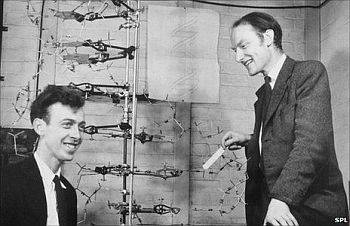
On the 28th February 1953, Jim Watson and Francis Crick made what was arguably the greatest scientific discovery of the 20th Century. They had an insight into the 3-dimensional structure of DNA (Deoxyribonucleic Acid). At lunch that day they told the pub-landlord “we have just discovered the secret of life”. Two months later their publication appeared in Nature.
What they uncovered was not only an explanation of how DNA was put together, but at they same time its structure revealed how inheritance worked, how genes could be passed from one generation to the next. Molecules like DNA are very small – the diameter of a DNA molecule is 2 millionths of a millimeter. But they are very long – every human cell (and there are 35,000 in a piece of skin the size of a pinhead!) contains two meters of DNA. So a pin-head of skin would contain 70kms of DNA.
Today we are all acutely aware of the potential for DNA in identifying the difference between horse meat and beef, as well as its use at crime scenes. But there are other amazing uses scientists can put it to: Identifying relationships – The English King Richard the III was recently identified using a living descendant in Canada; we can find out how old a population of plants and animals are – which helps us put together the story of how different species of plants first reached Ireland; with rare plants we can identify the genetic diversity still remaining in the species, which may be vital to plan any breeding programs.
THE IRISH LINK
There were three Nobel prize winners for the discovery of the DNA double helix; Jim Watson, Francis Crick and Maurice Wilkins. Jim’s mother was Irish, and Maurice’s parents had emigrated to Australia from Ireland before he was born. So between them the nobel prize winners had 3 Irish parents, making this a 50% Irish discovery.
Watson and Crick were both independently inspired by a short book published a few years earlier in Dublin, titled “What is life” by the Austrian physicist Erwin Schrödinger. Fleeing Nazi Germany in 1939, Schrödinger was invited by the then Taoiseach of Ireland, Éamon de Valera, to help establish the Institute for Advanced Studies in Dublin. He moved to Clontarf, where he lived until 1955. In a series of lectures at the Institute, Schrödinger addressed the phenomenon of life from the point of view of physics, and from first principles explained how genetic information might be stored in a molecule, and how life in many ways defied the second law of thermodynamics – unlike everything else in the universe life somehow becomes more ordered rather than the other way round.
THE ULTIMATE STORAGE MEDIUM?
DNA is remarkably permanent and accurate – DNA has been recovered from fossils of Neaderthals that were alive hundreds of thousands of years ago. In January of 2013 a group of scientists perfected information storage using DNA. They encoded all of Shakespeare’s Sonnets as a text file, an audio files of Martin Luther’s “I have a dream” speech, a pdf document of Watson and Crick’s original publication, a photograph of their laboratory building and finally the instructions to read back the code, into a DNA molecule. This was then given to another laboratory that was able to read back all the information without a single error. In total the DNA held 700 Megabytes of information, and was less than a millimeter in length (0.6mm). This method would enable all the video information currently on the planet to be held in a single teacup full of DNA.
2013 is the year of the Gathering2013, and it is appropriate that it is also the 60th anniversary of the discovery of the DNA double helix, since it is our shared genes that unites the Irish diaspora.
MAKE YOUR OWN ORIGAMI DNA MODEL
You can make a model of DNA from a single sheet of paper. Download the sheet below and using the instructions you should be able to construct your very own DNA molecule.
